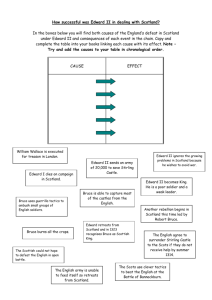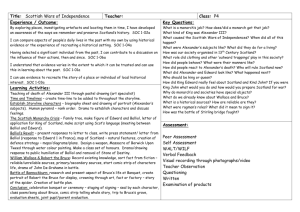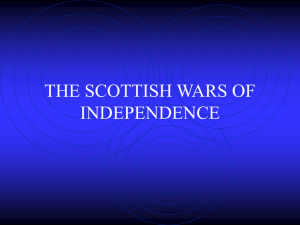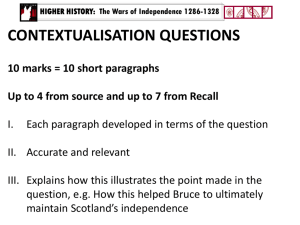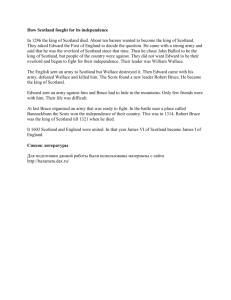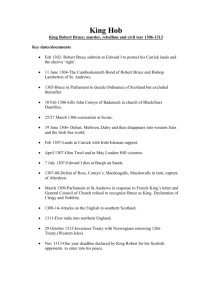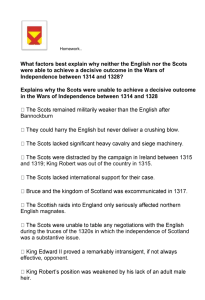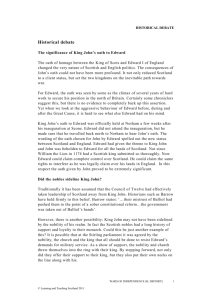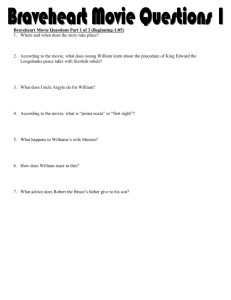Wars of Independence
advertisement
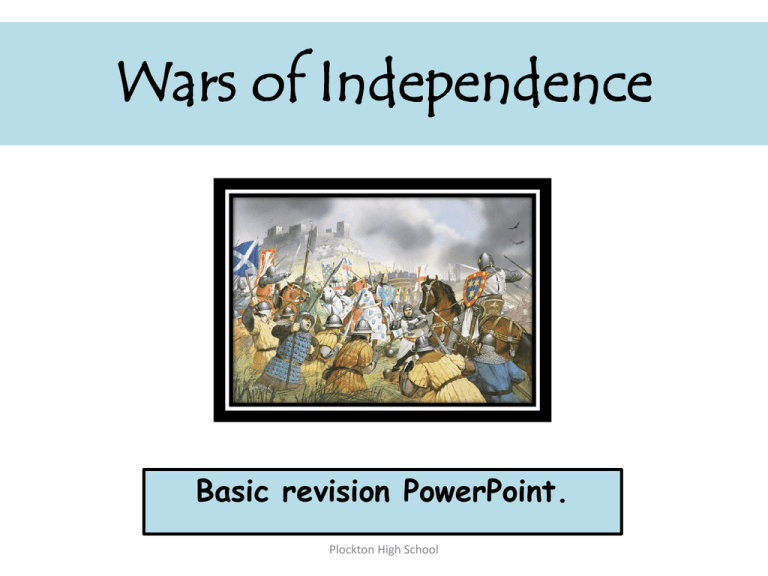
Wars of Independence Basic revision PowerPoint. Plockton High School Describe the events leading to the death of Alexander III. • After a meeting with his council in Edinburgh, Alexander made his way back (on horse back) to Kinghorn in Fife to be with his new wife Yolande. • There was a violent storm and Alexander was planning to cross the River Forth. • Due to the weather, he was advised against this and offered a bed at Inverkeithing but refused. • He continued his journey along a narrow seapath and in the darkness he lost his guides. • Alexander had fallen from the cliff and he was found the following morning. Plockton High School Explain the reasons why Scotland asked Edward I for help… • Edward passed strong laws which controlled England. He could help prevent law and order problems in Scotland. • Edward was Margaret’s great uncle and as a relative could help Scotland. • Many nobles had land in England so they looked to Edward for help. • There was no strong male heir to the Scottish throne and people were worried that war would break out between nobles who wanted control e.g. Bruce and Balliol. • Edward already controlled England and Wales and showed a keen interest in Scotland. • Edward was seen as a good Christian King. Scottish Bishops believed he would maintain good order. Plockton High School Explain the reasons why many Scots reluctant to accept Margaret as Queen of Scots… • Child: needed others to rule on her behalf. People worried this would lead to disputes. • Female: Many thought females would be weaker than a King and unable to control the noblemen. • Would need a husband; – A Scottish husband may cause jealousy among the other nobles. – A foreign husband could lead to Scotland being taken over and controlled by another country. • She was only 3 years old. Many children died before reaching adult hood so many were concerned that she would die young. So, an adult ruler would be best. • Many nobles wanted to be King so didn’t want her to rule e.g. Bruce and Balliol. Many feared this would lead to fighting amongst nobles and eventual civil war. Plockton High School Describe the Treaty of Birgham, 1290. • The Treaty of Birgham stated that Margaret, Maid of Norway (to be Queen of Scots) would marry Edward I’s son. • The Treaty stated that Scotland shall remain separate and divided from the Kingdom of England. • The Treaty also stated that Scotland shall keep her rights, laws, freedoms and customs. • A further point of the treaty was that all Scottish parliaments must be help in Scotland and nowhere else. • Finally, the ruler of Scotland and the ruler of England shall freely rule their own kingdoms. Plockton High School Describe Edward I’s steps to Overlordship. 1. Alexander III died without any sons. As such there were no direct male heirs to the throne. 2. Margaret, Maid of Norway died soon after reaching Orkney. Removes Scotland’s direct heir. 3. Rivalry amongst nobles led to fear of civil war. When they heard of her death, they (e.g. Bruce) began gathering their forces. 4. Edward I asked to help by the Scottish Guardians. Edward then convinces Guardians to resign so he could replace them. Edward begins taking control of Scottish castles. 5. Meeting at Norham: Bishop Fraser of St Andrews asks Edward to come to the border with troops to save Scotland from civil war. Edward arrives saying he is there for the ‘Overlordship which belongs to me’. The nobles agree that he is Overlord. Plockton High School Explain the reasons why Edward I chose Balliol to become King of Scots? • Balliol agreed to pay homage to King Edward • Balliol agreed that Edward was Overlord of Scotland • Balliol was descended from the eldest daughter of Earl of Huntingdon • Balliol was nearest heir of Margaret, Maid of Norway • Several Scots nobles felt they should be King; there was fear of civil war. Plockton High School Explain the reasons why there was a succession crisis… • King Alexander III had died without leaving a male heir • Alexander III's closest relation was the Maid of Norway • There were doubts about being ruled by a female (leadership in war) • The Maid was very young – she could die • There would be problems in the future finding a husband for the Maid • Several Scots nobles thought they had a claim to the throne. (Balliol, Bruce) • There was the possibility of a civil war in Scotland. Plockton High School Describe the attack on Berwick. • • • • • The people built a new, wooden wall around the town Soldiers from Fife came to defend the town Women and children were moved out of the town Edward surrounded Berwick by land and sea Edward asked Berwick to surrender within 3 days. The defenders would not surrender • The people of Berwick mocked King Edward by shouting insults at him such as ‘Lang Shanks’ (long legs) • Edward attacked the town by sailing his ships into the harbour to attack from the sea • English soldiers charged across the wall & into the town killing everyone they could find and burned Berwick to the ground Plockton High School Describe the events of the Battle of Dunbar. 1. On 23 April, English cavalry - led by Edward’s senior commander John de Warrene, Earl of Surrey - was sent to besiege the castle 2. After 4 days the Scots led by the Earl of Buchan attacked the English 3. The castle garrison cheered and raised banners taunting English 4. Warrene and his knights rode down the valley and out of sight 5. The Scots thought the English were fleeing and broke ranks to pursue them 6. The English then attacked 7. Scots suffered huge defeat 8. Many Scottish nobles captured Plockton High School Describe the effects of the Battle of Dunbar. • Roxburgh surrendered after a few days of sporadic fighting. • Jedburgh and Edinburgh castles held off Edward’s troops for a little longer, but when his powerful new siege engines arrived the castles quickly surrendered, not wishing to withstand the bombardment. • Stirling did not even put up a fight. The caretakers of the castle were left with the keys by the defenders as they fled an approaching army. • King John and the Comyn lords retreated to the north east, and there they contemplated surrender. • Only on the west coast did Alexander, head of the powerful MacDougall clan, put up any kind of resistance. • Almost 1600 Scots swore loyalty to Edward in the Ragman’s Roll. Plockton High School Describe the defeat & capture of John Balliol. • John Balliol and the Scots had made an alliance with France against Edward • John Balliol had renounced his homage to King Edward • A number of Scots refused to support King John (eg Bruce) • John Balliol’s men had attacked the north of England • King Edward had shocked the Scots by destroying Berwick • King Edward had defeated King John’s army at Dunbar • King Edward had pursued King John to the north of Scotland • King John had surrendered to King Edward • King Edward had stripped King John of his title and crown. Plockton High School Explain the reasons why Balliol failed as King… • John Balliol had accepted Edward I as his overlord • John Balliol had been bullied by King Edward (e.g. orders, legal decisions overturned) • John Balliol refused King Edward’s order to join him in a war against France • John Balliol withdrew his homage to King Edward • John Balliol had made an alliance with the King of France against Edward i.e. treason • King Edward defeated John Balliol at Dunbar • King Edward forced John Balliol to surrender to him • King Edward had stripped John Balliol of his crown and title • Robert Bruce had been plotting against John Balliol • Not all the Scots supported Balliol in his campaign against King Edward. Plockton High School Describe the ways in which Edward I controlled Scotland after the defeat of John Balliol/Explain the reasons why the Scots rebelled… • Nobles : Edward used many ways to control the nobles who usually ran Scotland e.g. offering land in England. • Prison: John Balliol and many Scottish leaders were his prisoners in England. • Hostages: Edward had taken the sons and relations of other noblemen to England to make sure that they did what he wanted. • Promises of Loyalty: all the important people in Scotland had promised to obey him by signing the Ragman Roll. • Castles: Edward had given Englishmen control over important Scottish castles. • Government: Edward had chosen Englishmen to govern Scotland. The Earl of Sussex was in charge, but he left most of the work to the Treasurer, Cressingham. They were based in Berwick. • Church: Edward decided that only Englishmen were to be promoted in the Scottish Church. Many of the Scottish churchmen continued to resist Edward. Bishop Fraser of St Andrews, the most important churchman in Scotland, was in France. He never agreed that Edward was his king. Plockton High School Why was Wallace an Outlaw by 1297? • • • • • Murdered Sheriff of Lanark Attacked Ormsby Hid in Selkirk forest Joined by other outlaws and serf Was part of rebellion sweeping through Scotland against the rule of Edward I • Did not sign the Ragman’s Roll Plockton High School Describe the events of the Battle of Stirling Bridge. • The Scots and English were on different sides of the bridge • The Scots were formed up on the high ground (Abbey Craig) • The English were slow in getting organised (slept in and/or a knighting ceremony) • The English debated whether to use Stirling Bridge or a slightly distant ford • The English crossed the bridge (which was narrow) slowly • Wallace ordered the Scots to attack the English when enough had crossed to defeat them • The Scots cut off the end of the bridge and isolated the English/many were drowned • The English were defeated/Cressingham was killed. Plockton High School Explain the reasons why the Scots won the Battle of Stirling Bridge? • English were over confident and did not plan their tactic • Scots positioned themselves on Abbey Craig • Scots made English cross Stirling Bridge which was too narrow for the English cavalry • Scots attacked the English as they tried to cross the bridge • Wooden Bridge collapses and the English panic as the horses and knights are drowned and many are slain by Scots • Cressingham (English leader) is killed Plockton High School Describe the events of the Battle of Falkirk. • • • • • • Wallace gathered his army between a loch and forested hills Wallace positioned his men in schiltrons King Edward’s first attack on the schiltrons was unsuccessful The Scottish cavalry (knights) fled when Edward advanced King Edward’s men massacred the Scottish archers English archers fired into the Scottish schiltrons and killed many men • Edward’s men then killed the survivors in the Scottish schiltrons • The Scots were heavily defeated. Plockton High School Explain the reasons why the English won at the Battle of Falkirk? • Pitched battle on open ground, a mistake by Wallace (English close to mutiny) • English advantages as regards size of army - 2000 knights, 12,000 infantry • English better equipped - Longbow men who were experienced in battle • Leadership of Edward I - experienced and ruthless general • Disloyalty/panic of Scots nobles who fled leaving Scots archers unprotected Plockton High School Explain the reasons why Wallace become Guardian of Scotland… • Common people supported him • Nobles were powerless without support of common people • Acted as a middle man between divided nobles • Acted in King John’s name but he had family links with the Bruces • Had support of the Church – Bishop Lamberton, the Bishop of St Andrews (took over after Bishop Fraser died) Plockton High School Describe Wallace’s capture and execution. • Wallace betrayed and captured near Glasgow by Sir John de Menteith (Sheriff of Dumbarton) (August 1305) • Taken to London/tried at Westminster Hall • Charged with treason and other crimes/not allowed to defend himself (outlaw) • Wallace claimed he had never accepted Edward as his King so could not be traitor • Wallace found guilty/sentenced to be hung, drawn and quartered at Smithfield • Cruelty of execution designed to frighten others thinking of opposing Edward (and revenge) Plockton High School Explain the reasons why Wallace’s leadership was important to the Wars of Independence… • He united people under his leadership as Guardian • He organised the army of Scotland • He sent Lamberton to Rome and Paris to plead Scotland’s case there • He obtained iron from Germany for his army. • He defeated the English at Stirling Bridge • He developed the idea of fighting in schiltrons • He made sure that Edward did not select the new Bishop of St. Andrews • He continued to resist Edward till he was executed. Plockton High School Explain the reasons why the Scots recognised Edward’s authority by 1305… • Executed Wallace • Captured important nobles • Edward punished Scottish nobles by fines or exile • Scots were demoralised; Edward had marched an army to the north of Scotland • Edward was quite lenient in his fines/punishments over Scotland Plockton High School Describe the murder of Comyn. • Met at Greyfriar’s Kirk, Dumfries • Argument broke out - historical debate about the content. • Bruce stabbed Comyn • Bruce ran out to tell his supporters what he’d done • Bruce’s supporters went into Church and killed Comyn • N.B. This is the Scottish account of the murder Plockton High School Explain the reasons why the murder of Comyn was significant for Bruce… • The Scots became further divided in support of Bruce and Balliol. • Scottish Churchmen were angry as Bruce had committed sacrilege • The Pope excommunicated him from the Catholic Church • The Comyns wanted revenge • Edward I sent an army north Plockton High School Describe the effects of the murder of Comyn. • Scots Further divided in support between Bruce and Balliol • Church For committing ‘sacrilege’ (murder in a holy place) • Pope Excommunicated (being cast out of Roman Catholic Church) • Comyns Wanted revenge • Edward I Treason had been committed Edward sent an army north Plockton High School Explain the reasons why the Scots were divided in support for Bruce and Balliol? • Many nobles had been fighting for King John Balliol since 1297 and were reluctant to just throw him aside • Bruce’s claim to the throne was really nonexistent • Bruce often sided with Edward • Balliol was no longer in the country & had been defeated & discredited • Bruce had killed Comyn in a Church Plockton High School Describe Bruce’s coronation. • • • • • • Held at Scone Sat on Stone of Destiny Earl of Fife placed new King on the Stone Scots crown placed on heirs head Wore Kingly robes Many important Scots attended Plockton High School Explain the reasons why Bruce was successful in making himself King? • Had some royal blood • Support from Church e.g. Bishop Wishart • Support from some nobles e.g. Angus Og MacDonald • Squashed opposition by burning their land e.g. Comyns & friends • Death of Edward I. Edward II showed little interest in Scotland. Plockton High School Explain the reasons why Bruce was nicknamed King Hob in the first year of his reign… • Two of his brothers were executed after Raid on Carrick • Bruce was forced to flee from the English • His sister and the Countess of Buchan were placed in cages • His wife was placed under house arrest • His daughter was imprisoned in the Tower of London Plockton High School Describe the methods used by Bruce to defeat the English. • Ambushed groups • Won support of powerful nobles e.g. Angus Og MacDonald • Captured castles e.g. Roxburgh (Mingled with the cows!) • Destroyed castles e.g. Perth • Demoralised the English soldiers by capturing garrisons and guerilla tactics Plockton High School Explain the reasons why Bruce destroyed castles… • Lacked the man power to defend castles against English • Scottish rivals could easily have gone against Bruce if they had castles to hide in. • Castles were centres of military power. • Invaders would have nowhere to shelter. • Castles could be re-occupied by English and would need re-capturing. Plockton High School Explain the reasons why Edward I’s death encouraged the Scots… • Ed I had been a strong King determined to control Scotland. • Ed II was weak, no military experience and no interest in Scotland. • Ed II had gone to Scotland but had turned back at Cumnock – leaving Bruce free to fight his personal enemies • English garrisons left without any leadership • Rumours swept through Scotland of a prophecy of Merlin. “Once the ‘greedy King’ had died, Scotland and Wales will win their independence”. Plockton High School Explain the reasons why the Scots won the Battle of Bannockburn? • Bruce’s leadership was key – experienced in battle • Men were trained to fight in mobile schiltrons • Good battle ground which suited his men • English – tired & disheartened • Small folk – panicked the English • Important Commanders & soldier fighting for him. Plockton High School Explain the reasons why there was no serious opposition to Bruce after 1314? • Bruce defeated the English at Bannockburn; after such heavy losses the English were reluctant to send another army to Scotland. • Edward II was facing rebellion against his rule by some of the most powerful English noblemen. • Scots armies raided as far as York showing that Edward II could not protect his people. • Bruce had defeated the Comyns who were his main rivals in Scotland. • Bruce gave land and power to his most trusted and loyal supporters; Bruce forced Scottish noble to give up their land in England so they had no obligations to Edward II. • The Declaration of Arbroath was sent to the Pope to win his support. • In 1328 the English were forced to make peace and accept Bruce as the lawful king of Scotland. Plockton High School Describe the purpose of the Declaration of Arbroath. • Scotland would be and remain an Independent Kingdom • Remove a King if he demonstrated disloyalty • Demonstrate support for Bruce • Outline the wrongs done to Scotland • Ensure the Pope accepts Bruce as King • Get the Pope to end ex-communication Plockton High School Explain the reasons why the Declaration of Arbroath sent to the Pope in 1320? • The Scots wanted the Pope to recognise Bruce as King of Scots. • King Edward II would not agree that Bruce was King of Scots; the Pope could put pressure on Edward to change his policy • The raids on Northern England had not been successful • The Scots wanted Bruce recognised internationally as King of Scots; the Pope was a person of international authority. • The invasion on Ireland had failed to put pressure on Edward II Plockton High School Describe the events leading to the Treaty of Edinburgh. • Edward II made short truces with Scotland – he was deposed and murdered • His son Edward III became King – only 14 so too young to rule. His mother Isabella and Mortimer ruled for him. This was unpopular. • By 1328, Bruce was ill and wanted a quick truce so ordered ferocious attacks on Northern England • England could not afford another war so talks began at Newcastle. • Talks moved to Edinburgh, where peace was agreed on 17th March, 1328 in the ‘Treaty of Edinburgh’. Plockton High School Describe the purpose of the Treaty of Edinburgh. • • • • • • Bruce recognized as King of Scots Balliol denounced Bruce’s son David would marry Edward III’s sister Joan Scots govt. records to be returned to Scotland Scots to pay £20,000 to England over 3 yr period No one in Scotland could hold land in England and vice versa • Scotland and England to have a military alliance • Edward III would use his influence to have Pope lift Bruce’s excommunication Plockton High School Explain the reasons why it took so long for the Scots to accept Bruce as King of Scots? • He had to force many Scots to abandon Balliol in his favour. • He killed Comyn in a church—had been excommunicated by the Catholic Church. • It took a long time to drive the English out of Scottish castles. • The Comyns were longstanding rivals and powerful family with strong supporters. • Bruce’s wars in Ireland had ended in disaster. Plockton High School
